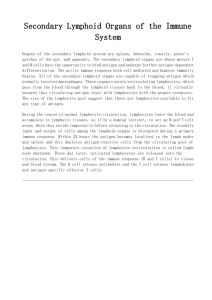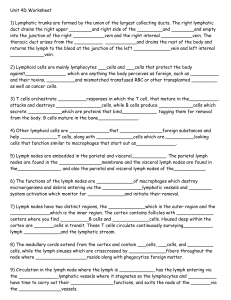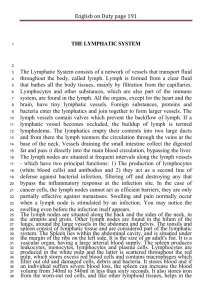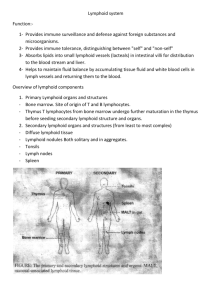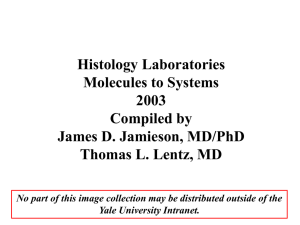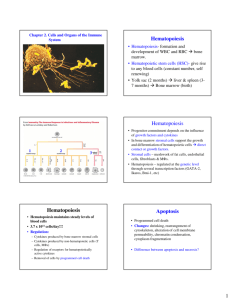Histology Lab I
advertisement
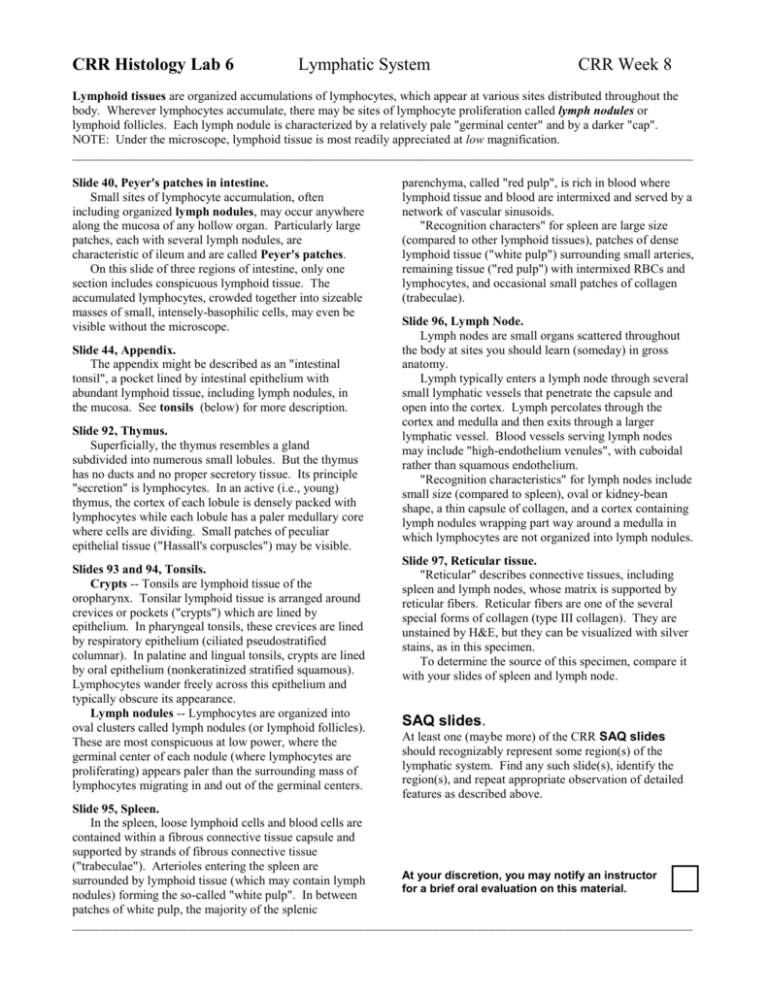
CRR Histology Lab 6 Lymphatic System CRR Week 8 Lymphoid tissues are organized accumulations of lymphocytes, which appear at various sites distributed throughout the body. Wherever lymphocytes accumulate, there may be sites of lymphocyte proliferation called lymph nodules or lymphoid follicles. Each lymph nodule is characterized by a relatively pale "germinal center" and by a darker "cap". NOTE: Under the microscope, lymphoid tissue is most readily appreciated at low magnification. ___________________________________________________________________________________________________ Slide 40, Peyer's patches in intestine. Small sites of lymphocyte accumulation, often including organized lymph nodules, may occur anywhere along the mucosa of any hollow organ. Particularly large patches, each with several lymph nodules, are characteristic of ileum and are called Peyer's patches. On this slide of three regions of intestine, only one section includes conspicuous lymphoid tissue. The accumulated lymphocytes, crowded together into sizeable masses of small, intensely-basophilic cells, may even be visible without the microscope. Slide 44, Appendix. The appendix might be described as an "intestinal tonsil", a pocket lined by intestinal epithelium with abundant lymphoid tissue, including lymph nodules, in the mucosa. See tonsils (below) for more description. Slide 92, Thymus. Superficially, the thymus resembles a gland subdivided into numerous small lobules. But the thymus has no ducts and no proper secretory tissue. Its principle "secretion" is lymphocytes. In an active (i.e., young) thymus, the cortex of each lobule is densely packed with lymphocytes while each lobule has a paler medullary core where cells are dividing. Small patches of peculiar epithelial tissue ("Hassall's corpuscles") may be visible. Slides 93 and 94, Tonsils. Crypts -- Tonsils are lymphoid tissue of the oropharynx. Tonsilar lymphoid tissue is arranged around crevices or pockets ("crypts") which are lined by epithelium. In pharyngeal tonsils, these crevices are lined by respiratory epithelium (ciliated pseudostratified columnar). In palatine and lingual tonsils, crypts are lined by oral epithelium (nonkeratinized stratified squamous). Lymphocytes wander freely across this epithelium and typically obscure its appearance. Lymph nodules -- Lymphocytes are organized into oval clusters called lymph nodules (or lymphoid follicles). These are most conspicuous at low power, where the germinal center of each nodule (where lymphocytes are proliferating) appears paler than the surrounding mass of lymphocytes migrating in and out of the germinal centers. parenchyma, called "red pulp", is rich in blood where lymphoid tissue and blood are intermixed and served by a network of vascular sinusoids. "Recognition characters" for spleen are large size (compared to other lymphoid tissues), patches of dense lymphoid tissue ("white pulp") surrounding small arteries, remaining tissue ("red pulp") with intermixed RBCs and lymphocytes, and occasional small patches of collagen (trabeculae). Slide 96, Lymph Node. Lymph nodes are small organs scattered throughout the body at sites you should learn (someday) in gross anatomy. Lymph typically enters a lymph node through several small lymphatic vessels that penetrate the capsule and open into the cortex. Lymph percolates through the cortex and medulla and then exits through a larger lymphatic vessel. Blood vessels serving lymph nodes may include "high-endothelium venules", with cuboidal rather than squamous endothelium. "Recognition characteristics" for lymph nodes include small size (compared to spleen), oval or kidney-bean shape, a thin capsule of collagen, and a cortex containing lymph nodules wrapping part way around a medulla in which lymphocytes are not organized into lymph nodules. Slide 97, Reticular tissue. "Reticular" describes connective tissues, including spleen and lymph nodes, whose matrix is supported by reticular fibers. Reticular fibers are one of the several special forms of collagen (type III collagen). They are unstained by H&E, but they can be visualized with silver stains, as in this specimen. To determine the source of this specimen, compare it with your slides of spleen and lymph node. SAQ slides. At least one (maybe more) of the CRR SAQ slides should recognizably represent some region(s) of the lymphatic system. Find any such slide(s), identify the region(s), and repeat appropriate observation of detailed features as described above. Slide 95, Spleen. In the spleen, loose lymphoid cells and blood cells are contained within a fibrous connective tissue capsule and supported by strands of fibrous connective tissue ("trabeculae"). Arterioles entering the spleen are At your discretion, you may notify an instructor surrounded by lymphoid tissue (which may contain lymph for a brief oral evaluation on this material. nodules) forming the so-called "white pulp". In between patches of white pulp, the majority of the splenic ___________________________________________________________________________________________________ □


